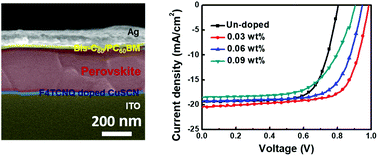Molecular doping of CuSCN for hole transporting layers in inverted-type planar perovskite solar cells†
Abstract
Among many strategies to develop high-performance perovskite solar cells, interface engineering is considered as a promising approach for achieving high power conversion efficiency. Specifically, high optical transparency and excellent electrical properties are essential for optimized hole transport materials in inverted-type planar perovskite solar cells. In this study, we demonstrate that the molecular doping of copper thiocyanate (CuSCN) by 2,3,5,6-tetrafluoro-7,7,8,8-tetracyanoquinodimethane (F4TCNQ) significantly enhances the photovoltaic performance of perovskite solar cells. The incorporation of F4TCNQ into CuSCN leads to successful electron transfer from CuSCN to F4TCNQ, which affords more balanced energy level alignment at the interface of the perovskite layer for hole conduction. Device analyses reveal faster charge transport and less carrier recombination in the F4TCNQ-doped CuSCN-based devices, contributing to not only the improved efficiency but also the hysteresis elimination. At the optimized doping concentration, the doped CuSCN exhibited an ∼35% increased efficiency as high as 15.01% in the inverted-type planar perovskite solar cells.



 Please wait while we load your content...
Please wait while we load your content...